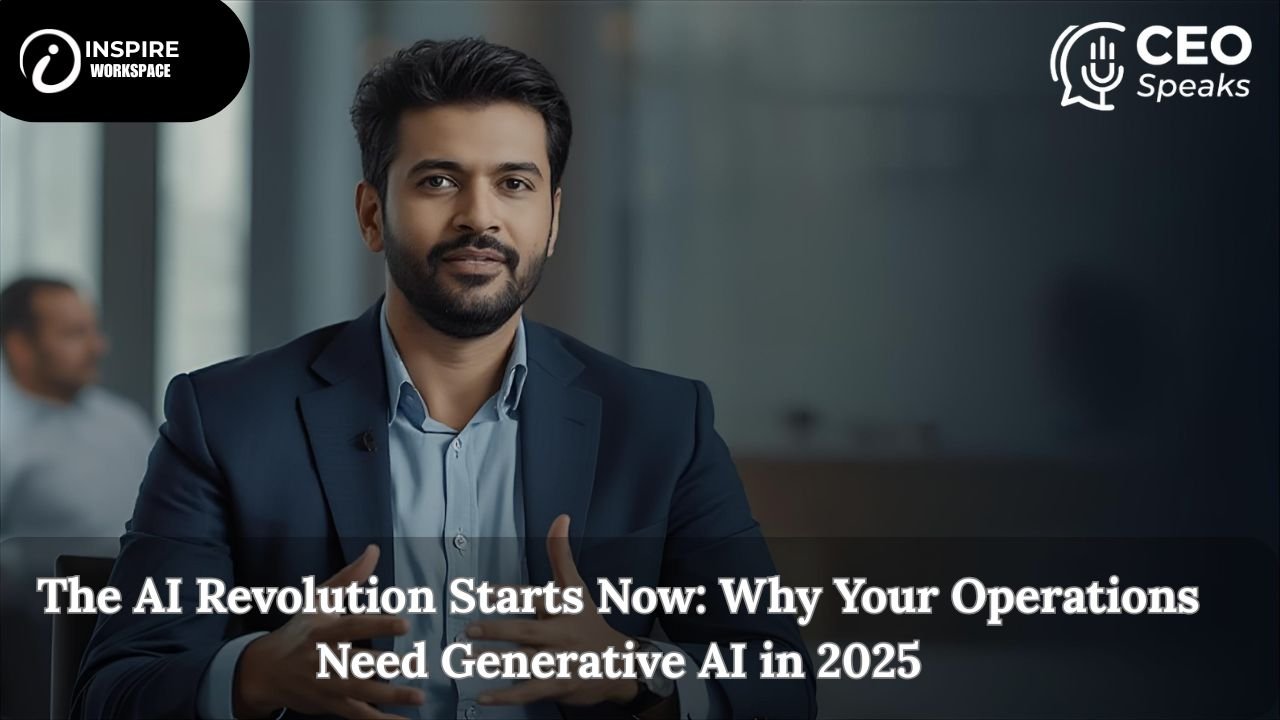As we navigate an increasingly complex business landscape in late 2025. I’ve come to realize that generative AI is no longer a “nice-to-have” innovation—it’s the strategic imperative that separates market leaders from followers. For over a decade, I’ve built businesses around digital transformation, operational excellence, and automation. Today, I want to share what I’ve learned about integrating generative AI into operations and why every CEO must act now.
The Moment of Truth: Why This Transformation Matters
When I first considered implementing generative AI across my organizations, I faced the same skepticism many leaders do. “Is this really different from previous waves of automation?” “Will it actually deliver ROI or just add complexity?” The answer I discovered: generative AI fundamentally reimagines how work gets done—not just by making existing processes faster, but by eliminating inefficient processes altogether and creating entirely new workflows
According to recent research, organizations using generative AI transformation 2025 in back-office operations are experiencing a 41% increase in productivity. That’s not marginal improvement—that’s transformational. But productivity gains alone don’t capture the full picture. The real power lies in freeing your best people to focus on high-value, strategic work while AI handles the repetitive, time-consuming tasks that drain both resources and employee engagement.
Beyond Automation: Reimagining Your Operating Model
The fundamental shift CEOs need to understand is this: generative AI isn’t about automating tasks—it’s about reimagining workflows.
In my digital marketing agency and co-working operations, I’ve seen how this plays out. In HR and finance functions—specifically in areas like source-to-pay processes and record-to-analyze workflows—generative AI doesn’t just speed things up. It transforms the back office from a cost center into a strategic nerve center. Instead of drowning in transactional work, operations teams become workflow orchestrators, designing systems that respond dynamically to business needs.
Consider what this means practically:
- Content Creation at Scale: My team previously spent weeks creating personalized marketing collateral. Now, generative AI generates thousands of variations in hours, maintaining brand consistency while adapting to audience segments.
- Customer Service Transformation: Rather than hiring additional support staff, AI-powered chatbots handle routine inquiries 24/7, escalating complex issues to humans who can actually add creative problem-solving.
- Data-Driven Decision Making: Predictive analytics powered by generative AI help me forecast market trends, manage inventory, and identify operational bottlenecks before they become crises.
The Three Pillars of Successful AI Integration
Through my implementation journey, I’ve identified three critical pillars that determine success or failure. Miss one, and the entire initiative stumbles.
Pillar 1: Start Small, Scale Fast with Intentional Pilots
The biggest mistake I see leaders make is trying to implement generative AI across the entire organization simultaneously. It’s tempting when you see the potential, but it’s a recipe for failure.
Instead, identify 2-3 low-risk use cases where success is measurable and visible. For me, this was automating content creation in marketing and developing an AI-powered customer service bot for the co-working space.
The beauty of pilots is that they provide immediate wins. Your team sees tangible benefits, adoption resistance decreases, and you learn what works in your specific context before scaling. These early victories also create internal champions—employees who become advocates for AI adoption because they’ve experienced the benefits firsthand
Key metrics to track in pilots:
- Time saved per process
- Quality improvement (where applicable)
- Cost reduction
- Employee sentiment and adoption rates
- Customer satisfaction impact
Pillar 2: Align AI with Clear Business Goals
This might sound obvious, but I’m surprised how often AI initiatives operate as standalone projects disconnected from core business strategy.
Every generative AI implementation must answer this fundamental question: How does this directly contribute to my business objectives? Whether your goal is reducing operational costs, improving customer experience, accelerating time-to-market, or scaling without proportional headcount increases, the AI solution must be tethered to that goal.l
In my organizations, I’ve identified that generative AI creates value in three primary ways:
- Efficiency Gains: Automating repetitive tasks frees up 15-20% of employee time for strategic work
- Quality Improvements: AI-generated first drafts and recommendations are often more consistent and higher-quality than rushed human work
- Speed to Market: Content creation, product design iterations, and customer response times all accelerate dramatically
Setting measurable KPIs is non-negotiable. Define what success looks like before implementation. For my content team, success is 30% faster campaign deployment with maintained or improved engagement rates. For customer service, it’s sub-2-minute response times with 90%+ first-contact resolution rates.
Pillar 3: Build Your AI-Ready Culture and Talent Strategy
Here’s the hard truth that research confirms: 64% of executives say success with AI depends more on people’s adoption than the technology itself.
Technology is the easy part. Culture is hard.
Employees naturally fear that AI means job losses. They’re skeptical about new tools. They’re concerned about being replaced. As a CEO who started as a practitioner in digital marketing, I understand these concerns deeply. My job is to reframe the narrative.
The AI tools I implement aren’t replacing people—they’re elevating people. A content creator using AI doesn’t become redundant; they become a creative director, focusing on strategy, storytelling, and brand voice while AI handles drafts and variations.
My AI adoption strategy includes:
- Transparent communication: I explain how AI will change workflows and emphasize that this creates career growth opportunities
- Hands-on training: Workshops and documentation help teams become comfortable with AI tools quickly
- Internal champions program: I identify early adopters and empower them to mentor colleagues
- Celebrating wins: When a team achieves significant efficiency gains, we celebrate it—not with job cuts, but with recognition
- Continuous upskilling: I invest in training programs so employees stay ahead of technology changes
The companies that win with AI will be those where employees see AI as a tool that makes their jobs more interesting, more impactful, and more rewarding.
Navigating the Integration Challenges: What I’ve Learned
Implementing generative AI isn’t frictionless. I’ve encountered real obstacles that other CEOs should prepare for:
Data Privacy and Compliance
Generative AI systems thrive on data, but this creates privacy challenges, especially under regulations like GDPR and CCPA. In my implementations, I work closely with legal and compliance teams to ensure that:
- Data is anonymized where possible
- Usage policies comply with all applicable regulations
- Employee and customer data is protected with encryption and secure API connections (not casual tools like ChatGPT, but enterprise-grade solutions)
The cost of getting this wrong far exceeds the cost of doing it right.
Bias and Fairness Issues
Generative AI models learn from historical data, which means they can inadvertently amplify existing biases. In hiring, content recommendations, and financial decisions, this can have serious consequences.
My approach: Regular audits of AI outputs for bias, diverse training datasets, and human oversight on high-stakes decisions. AI is an advisor, not a judge.
Integration Complexity
Most organizations have legacy systems that don’t naturally integrate with AI platforms. This requires technical expertise and cross-functional collaboration. I’ve found that cloud-based, API-driven solutions reduce integration friction significantly compared to trying to force AI into outdated infrastructure.
Talent Shortages
Quality data scientists and AI engineers are in high demand. Rather than trying to hire my way out of this problem, I’ve invested in:
- Upskilling existing employees through AI literacy programs
- Using no-code/low-code AI platforms that democratize access
- Partnering with external AI consultants for complex implementations
- Collaborating with universities to build a pipeline of future talent
The Financial Reality: ROI That Actually Matters
Let me be direct: generative AI implementation costs money upfront. Infrastructure, training, implementation consulting—it adds up. But the ROI can be staggering if you do it right.
In my operations, here’s what I’ve observed:
- Content teams: 30-40% time savings per project, with potential to increase output by 2-3x
- Customer service: 50-60% reduction in agent workload for routine inquiries, allowing teams to focus on complex cases
- Operations: 20-25% cost reduction through process optimization and automation
- Decision-making: Faster, more data-driven choices that reduce costly mistakes
The key is measuring against realistic baselines and being honest about what constitutes success.
The Strategic Imperative: Why Act Now?
If you’re waiting for generative AI to “mature” or for the technology to stabilize before you invest, you’re already behind. The competitive advantage accrues to early movers who build AI into their operating model—not as an afterthought, but as a core capability
Here’s what I tell my teams: In 2025, the question isn’t whether to adopt generative AI. It’s whether you’ll lead your industry’s AI transformation or follow your competitors.
The organizations that win will be those led by CEOs who:
- Understand that generative AI fundamentally reimagines workflows, not just accelerates them
- Make deliberate choices about where AI adds the most strategic value
- Build cultures where employees see AI as a partner in doing their best work
- Govern AI responsibly with frameworks that protect data, mitigate bias, and maintain ethical standards
- Measure relentlessly and iterate based on what actually works
Your Next Sztep
The time for exploration is over. Generative AI is reshaping business operations across every industry. If you haven’t already, start a pilot project in the next 30 days. Choose something measurable. Learn what works. Then scale.
The future belongs to organizations that master this transformation. As a CEO who’s spent the last decade building companies around automation and efficiency, I can tell you with confidence: generative AI isn’t the future—it’s the now. The question is whether your organization will lead or follow.
The best time to start was yesterday. The second-best time is today.




